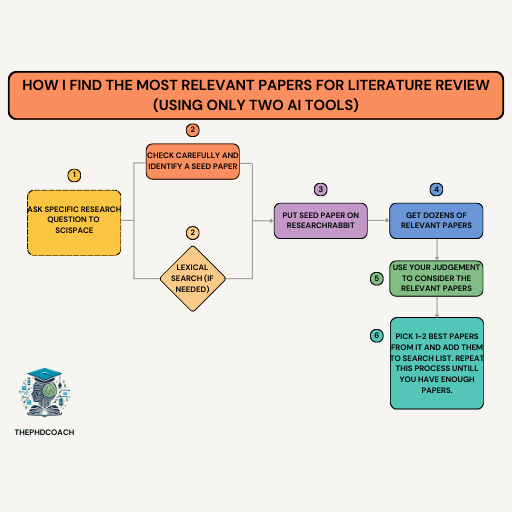
Conducting a literature review is a critical step in the research process. It allows scholars to understand the current state of knowledge, identify gaps, and establish the context for their work. However, manually searching for relevant papers can be daunting and time-consuming. Thanks to advancements in AI tools, this process can now be streamlined and made more efficient.
In this blog, we’ll explore how to leverage two powerful AI tools—SciSpace and ResearchRabbit—to find the most relevant papers for your literature review. This systematic approach ensures accuracy, saves time, and enhances the quality of your research.
Why a Specific Research Question is Essential
A well-defined research question forms the foundation of any successful literature review. It guides your exploration and ensures that you stay focused on relevant topics.
How to Use SciSpace for Your Research Question
SciSpace is an AI-powered tool designed to assist researchers in navigating academic literature. Begin by inputting your specific research question into SciSpace.
Example:
Suppose your research question is: “What are the most effective machine learning methods for detecting cyberattacks in real-time?”
What is a Seed Paper?
A seed paper is a foundational paper that closely aligns with your research topic. It serves as a starting point for further exploration.
How to Identify a Seed Paper
Tip:
If you’re unsure, conduct a quick lexical search to narrow down the options further.
When is a Lexical Search Useful?
If SciSpace’s initial suggestions are too broad or if your seed paper isn’t immediately apparent, a lexical search can help.
How to Perform a Lexical Search
Example Keywords:
For the question on cyberattacks, keywords might include:
What is ResearchRabbit?
ResearchRabbit is an AI-driven tool designed to create networks of research papers. It identifies related papers by analyzing citations, references, and similar topics.
Steps to Use ResearchRabbit
Why ResearchRabbit?
It’s especially useful for identifying seminal works and recent studies, ensuring you don’t miss important developments in your field.
Using Your Judgment to Assess Papers
Once ResearchRabbit provides a list of related papers, the next step is to evaluate their relevance.
Criteria for Evaluation:
Tips for Efficient Evaluation:
Narrowing Down the List
From the dozens of papers, select 1-2 that:
Iterative Process
Efficiency
These tools automate much of the search and sorting process, allowing you to focus on analysis rather than sifting through irrelevant papers.
Comprehensive Coverage
By leveraging AI algorithms and citation networks, you ensure a thorough review of the literature, including hard-to-find studies.
High-Quality Results
Both tools emphasize relevance, citations, and connections, ensuring you work with impactful research.
Combine AI Tools With Manual Judgment
While AI tools are powerful, your expertise and judgment are essential for interpreting and selecting papers.
Keep Your Research Question Central
Constantly refer back to your research question to ensure you stay on track.
Document Your Process
Maintain records of your seed papers, search criteria, and evaluation notes for easy reference and replication.
Conducting a literature review no longer has to be a tedious, time-consuming process. By integrating AI tools like SciSpace and ResearchRabbit into your workflow, you can streamline the process and uncover the most relevant research with precision. These tools not only save time but also enhance the quality and depth of your literature review.
Remember, while AI can significantly assist you, the final decisions should always align with your academic judgment and research goals. Use these tools iteratively and critically to build a robust foundation for your research.
1. What is the advantage of using AI tools for a literature review?
AI tools like SciSpace and ResearchRabbit automate the search process, saving time and ensuring comprehensive coverage of relevant literature.
2. Can I use these tools for any research topic?
Yes, both tools support a wide range of disciplines and research topics. However, their effectiveness may depend on the availability of data in your field.
3. How do I ensure I’m selecting the best seed paper?
Choose a paper that is highly relevant to your research question, frequently cited, and published in a reputable journal or conference.
4. Are there alternatives to SciSpace and ResearchRabbit?
Yes, alternatives include Connected Papers, Semantic Scholar, and Google Scholar for similar functionalities.
5. Is manual effort still required when using these tools?
Yes, while these tools streamline the process, your judgment is crucial in selecting and interpreting the most relevant papers.

Dr. Chopra is the founder and editor of thephdcoaches.blogs and Thephdcoaches Learn more about her here and connect with her on Instagram, Facebook and LinkedIn.
Dr. Tripti Chopra, founder of The PhD Coach, is an award-winning mentor and leader in integrating AI into academic research, with over a decade of experience guiding PhD students and researchers. Her work revolutionizes research processes, promotes sustainable writing practices, and inspires scholars to embrace technological advancements.
Copyright© 2023 Thephdcoach All rights reserved.
Leave a Comment